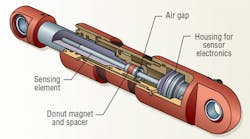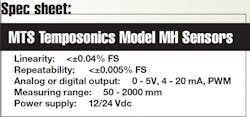Hydraulic cylinder position-sensing in the rugged environments typically encountered by construction, agriculture, and other off-highway mobile-equipment is critical. There are three reasons to consider sensors, such as Temposonics Model MH sensors:
The compact Model MH stainless-steel position sensors are specifically configured for installation in welded (as illustrated) and tie-rod style hydraulic cylinders with 50-mm or larger bores. They can be positioned from the head end or the rod end to suit the particular application.
The Model MH consists of three main components: a sensor head (a rugged enclosure for the electronics); a pressure-proof sensor tube that houses and protects the internal sensing element (or waveguide); and a donut-shaped permanent magnet — mounted on the piston — which travels along the stationary sensor tube without contacting it when the cylinder strokes.
Make contact: MTS Systems Corp., Sensors Div., Cary, N.C.
(919) 677-0100, www.mtssensors.com



